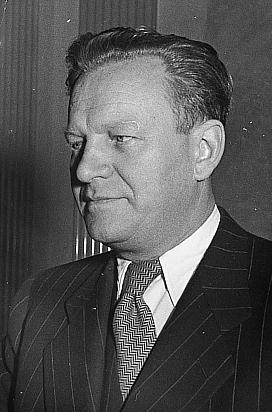Univ.-Doz. Dr. Karl Gruber

Personalia
Born:
Died:
Profession:
Persecution:
Dismissed in 1938,
Resistance fighter (undiscovered)
Honors:
Grand Decoration of Honor in Gold on Ribbon for Services to the Republic of Austria
Decoration of Honor for Services to the Liberation of Austria
Cross of Honor for Science and Art I. Class
Grand Cross of the Order of Isabel la Católica
Honorary Citizen of the University of Vienna
Memberships
Curriculum Vitae
In his youth, Karl Gruber went through the classic career path with the Social Democrats, from the "Red Falcons" to the "Socialist Workers' Youth" (SAJ) and the party. As a working student, he graduated from the Federal College for Building Construction and Electrical Engineering in Innsbruck with a degree in electrical engineering. He then joined the postal and telegraph directorate there. He also studied law and political science in Innsbruck, which he continued and completed in Vienna in 1935.
In 1934, he converted to Catholicism, left the Social Democrats and joined the Vaterländische Front. He made this switch from the social democratic to the Christian-social-patriotic camp "out of political conviction and forced by specific circumstances of the time". He marries Helga Ahlgrimm. In 1935, he joins the student fraternity Austria Wien. After obtaining his doctorate in law in 1936, he worked as a member of the Christian trade unions in the postal and telegraph service in Vienna. He also worked as a research assistant to the Greater German national economist Hans Mayer (1879-1955).
The invasion of Austria by the German Wehrmacht in 1938 prevented his habilitation and further academic career. He was dismissed from the postal service due to his activities in the Christian trade union. He then went to Berlin as an electrical engineer, first to AEG and then to Telefunken. Because he worked in companies important to the war economy - most recently as a high-frequency specialist in the development of radar - he was made "indispensable". During this time, he came into contact with other opponents of National Socialism, including the group around Carl Gördeler (1884-1945). Here he led a group of around 80 people, known as the Anti-Fascist Front (AGFA), in close cooperation with the Kreisau Circle and the Austrian Resistance Group O5. He manages to establish contact with representatives of British radio, which enables him to make the BBC's Austrian broadcasts more interference-free in collaboration with the jamming unit (head Carl Hirnschrott). He also maintained contact with the American embassy in Berlin until 1941. From the fall of 1944, he was able to get in touch with the American secret service OSS (Office of Strategy Services). The head of the American counterintelligence center in Zurich, Allan Dulles, appoints Karl Gruber as operations manager of the resistance groups in Innsbruck under the code name "Dr. Brandt".
In the course of the decentralization of the armaments factories, Karl Gruber manages to "abscond". He then reached Tyrol via Rudelstadt and Straubing. Because the Russians had already taken Baden, he made his way to Innsbruck on April 12, 1945, where he took over the leadership of the united Tyrolean resistance groups. On April 18, the Post group, which had left Thuringia of its own accord, also arrived in Innsbruck. One day later, Carl Hirnschrott reached Innsbruck and met Karl Gruber in the Kreuzschwestern sanatorium.
The Reichspost group now managed to keep the telecommunications systems undamaged and set up a bugging service. On May 3, 1945, Karl Gruber gave the order to occupy all strategically important facilities in the city with resisters, which was successful after some difficulties in disarming the still strong Nazi forces. At 2.45 p.m., he was able to report the disempowerment of the Nazis without bloodshed and the undamaged seizure of the technical facilities. The American communications officer arrives at 10 pm. This marked the end of the war for Innsbruck.
After the liberation of Austria, Karl Gruber was appointed Governor of Tyrol by the US military government until October 20, 1945. He joins the ÖVP-Kameradschaft der politisch Verfolgten und Bekenner für Österreich. Under Federal Chancellor Leopold Figl, he was Austrian Foreign Minister until 1953 and largely prepared the text of the State Treaty of 1955. He is therefore one of the formative figures of the post-war period. He then entered the diplomatic service and became ambassador to the USA, among other things. He was also the long-term president of the Latin American Institute in Vienna.
Places
Residence:
Multimedia
Citations
- Krause, Peter/Reinelt, Herbert/Schmitt, Helmut (2020): Farbe tragen, Farbe bekennen. Katholische Korporierte in Widerstand und Verfolgung. Teil 2. Kuhl, Manfred (ÖVfStG, Wien), p. 107/108.
Wikipedia unter de.wikipedia.org/wiki/Karl_Gruber_(Politiker,_1909)
